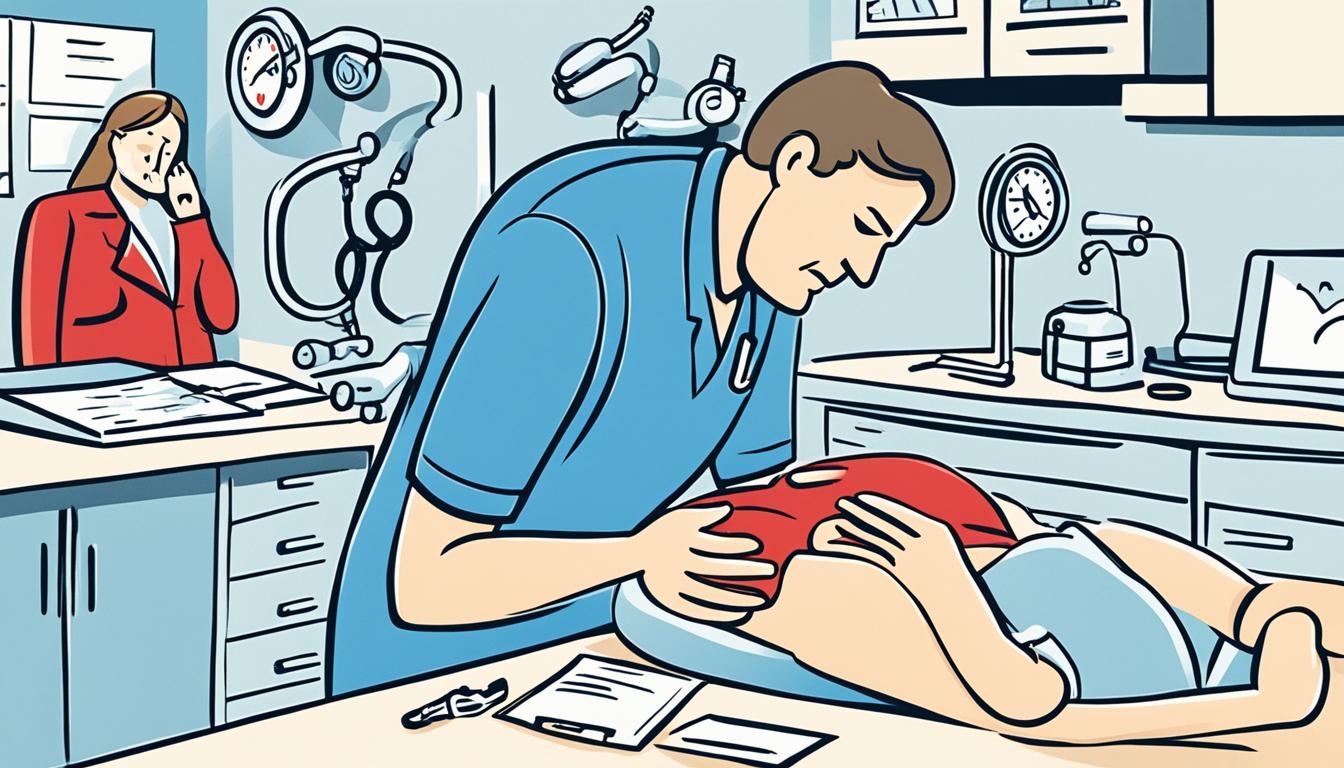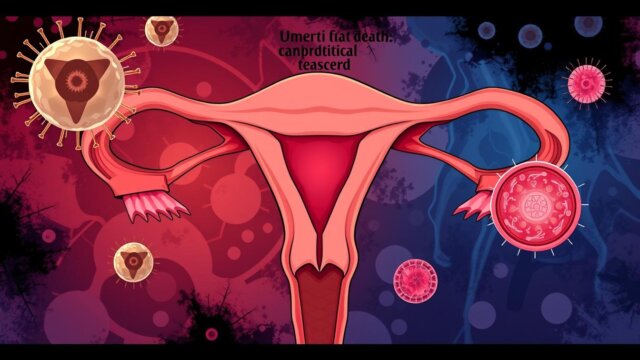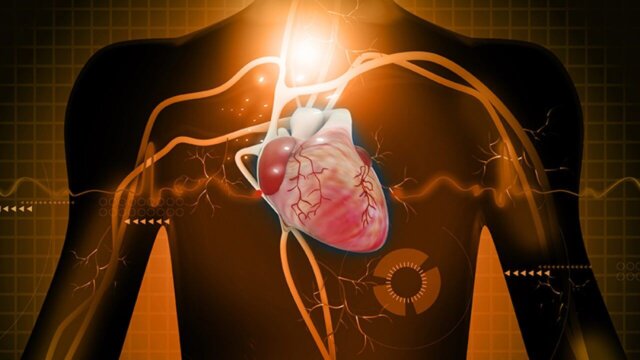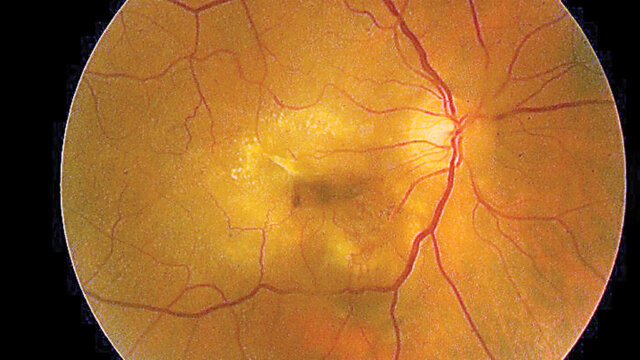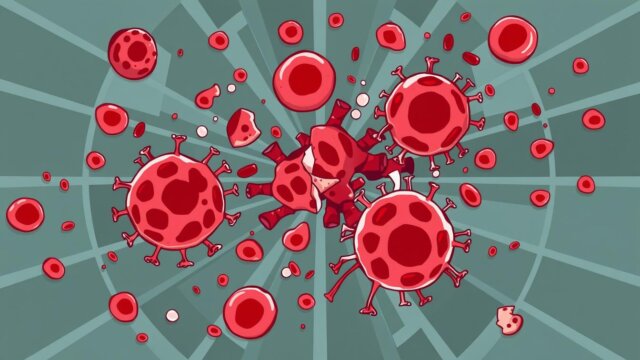FTC disclaimer: This post may contains affiliate links and we will be compensated if you click on a link and make a purchase.
Did you know that 5% of all emergency room visits are for abdominal pain? This issue can be felt from your ribs to your pelvis. It can be mild or very bad. You might feel aching, stabbing, burning, twisting, cramping, or just a dull pain.
It can come on suddenly, go away, or get worse over time. Knowing about abdominal pain is key to finding relief and fixing the problem.
Key Takeaways
- Abdominal pain is a common condition that affects 5% of emergency room visits.
- Abdominal pain can be acute, chronic, progressive, or colicky, with various underlying causes.
- The location and characteristics of abdominal pain can provide important clues to the underlying cause.
- Serious conditions like appendicitis, gallstones, and cancer can lead to abdominal pain.
- Proper diagnosis and treatment are essential for managing abdominal pain effectively.
What is Abdominal Pain?
Abdominal pain means feeling discomfort in the belly. It can come from problems with organs like the stomach, intestines, pancreas, liver, and gallbladder. If the pain is bad, it’s more serious than just a simple stomach ache.
Understanding the Anatomy of Abdominal Pain
The belly is split into four parts. Where the pain is can tell us what’s wrong. Pain in the top part might be from organs like the stomach or liver. Pain in the lower part could be from the intestines or ovaries in women.
Differentiating Abdominal Pain Types
Pain in the belly can start suddenly or last a long time. Sudden pain might be from appendicitis or a stomach ulcer. Pain that lasts months could be from IBS or a stomach ulcer.
Pain that gets worse can mean serious issues like cancer. Pain that comes and goes might be from kidney stones.
Knowing what the pain feels like can help figure out why. Stomach cramps with bloating are often from gas. Cramps and diarrhea might mean you have IBS.
Prevalence of Abdominal Pain
Many people suffer from abdominal pain. In fact, over half of people, 51.9%, have had it in the last 3 months.
About 11.0% of people often get pain after eating. This group often has more women and young people. They also have more gut-brain interaction issues.
People with more pain after eating often have more stomach issues. They also feel more stressed, have more body aches, and live a worse life.
Those with often pain after eating are more likely to see a doctor for stomach problems.
Even though many have abdominal pain, only about 2.8% of visits to doctors are for it. Many cases have no clear cause. Common causes include food poisoning, irritable bowel disease, bladder issues, and stomach problems.
One in 10 people with pain have serious conditions like appendicitis or cancer that need quick treatment.
Quadrants of Abdominal Pain
Doctors divide the abdomen into four parts to find the cause of abdominal pain. Pain in the upper right might mean liver or gallbladder issues. Lower right pain could suggest appendicitis. Left-sided pain might be from the pancreas or stomach, and lower left could be diverticulitis or irritable bowel syndrome.
The exact spot of abdominal pain helps figure out the cause. Upper abdominal pain could be from heartburn, ulcers, or a hiatal hernia. Lower abdominal pain might be due to gut issues, infections, menstrual cramps, or kidney stones.
Location as a Diagnostic Clue
The spot of abdominal pain is key to finding the cause. Upper abdominal pain could be from heartburn, ulcers, or a hiatal hernia. Lower abdominal pain is often from gut problems, infections, menstrual pain, or kidney stones.
If you have abdominal pain with vomiting blood, bloody stools, or no bowel movements, see a doctor. The treatment for abdominal pain depends on the cause. Don’t ignore severe or ongoing abdominal pain.
Quadrant | Potential Causes of Abdominal Pain |
|---|---|
Upper Right | Liver or gallbladder issues |
Lower Right | Appendicitis |
Upper Left | Pancreatic or stomach problems |
Lower Left | Diverticulitis or irritable bowel syndrome |
“The location of abdominal pain can be a crucial factor in determining the underlying condition.”
Things that increase the risk of abdominal pain include family history of gut issues and some pain medicines. Symptoms like gas, constipation, kidney stones, appendicitis, liver, and gallbladder diseases are linked to abdominal pain. Quick action is needed for abdominal pain, especially if it’s severe, unexplained, or with signs like vomiting, fever, or blood in stool.
Most folks will have abdominal pain at some point. Serious issues don’t always cause the worst abdominal pain. Less serious issues like constipation, irritable bowel syndrome, food allergies, and stomach flu can also cause abdominal pain.
Visceral receptors in the abdomen feel pain from stretch and chemicals. These receptors are found on the lining of organs and in the mesentery and walls of hollow organs.
Acute Abdominal Pain
Acute abdominal pain comes on suddenly, often in a few hours or days. It may have other symptoms. While most cases are not serious, like gas or indigestion, severe pain could mean a serious issue. This includes appendicitis or gallstones.
About 1.5 percent of visits to the doctor are for abdominal pain. In the emergency room, 5 percent of visits are for this reason. Up to 10 percent of these patients might need surgery for severe pain.
The pain’s location helps doctors figure out what’s wrong. Right upper quadrant pain could be from many things, like liver or gallbladder issues. For these, doctors often use ultrasound. But for pain in the right or left lower quadrant, they might use CT scans.
Some signs can point to the cause of the pain. Fever, pain moving, and tenderness can mean appendicitis or a blocked bowel. Fever, right upper quadrant pain, and fever can also mean gallbladder issues.
Seeing a doctor quickly is key for severe abdominal pain. They can check you out, run tests, and treat the real cause of the pain.

“Differentiation of abdominal pain location assists in the evaluation and diagnostics of conditions like appendicitis.”
Condition | Diagnostic Indicators |
|---|---|
Appendicitis |
|
Cholecystitis |
|
Pancreatitis |
|
Liver Conditions |
|
Acute abdominal pain needs quick medical help, as it could be serious. The pain’s location and other symptoms help doctors figure out what’s wrong. By getting help fast and doing tests, doctors can find and treat the cause.
Abdominal pain is a common reason for doctor visits, both in offices and emergency rooms. Some patients might need surgery for their pain.
Signs, Symptoms, and Causes of Acute Abdominal Pain
Right upper quadrant pain can be from many things, like liver or gallbladder problems. Doctors use ultrasound for these cases.
For pain in other areas, they might use CT scans. Knowing where the pain is helps doctors diagnose conditions like appendicitis.
Certain signs, like fever and tenderness, can point to appendicitis or a blocked bowel. For gallbladder issues, fever and right upper quadrant pain are signs.
A high white blood cell count can confirm appendicitis. Doctors recommend testing amylase and lipase for epigastric pain. Liver tests are important for right upper quadrant pain.
Abdominal pain can be from many things, like gas or a pulled muscle. It usually goes away in a few hours or days. But it can come back over time, showing a serious issue. It can be a sign of something serious, like appendicitis.
Chronic pain lasts more than three months and may have other symptoms. It could be from inflammatory bowel diseases like Crohn’s disease. Progressive pain means a serious illness, like cancer, is likely.
Chronic Abdominal Pain
Chronic abdominal pain is a common issue that can really affect someone’s life. It means having pain in the belly that lasts over 3 months. This pain can come and go, lasting from weeks to years. There are different types, like progressive pain that gets worse and colicky pain that comes in waves.
Conditions like irritable bowel syndrome, gallstones, and inflammatory bowel diseases can cause this pain. Some conditions, like Crohn’s disease, can make the pain get worse over time. People with chronic pain often miss work and visit doctors a lot, more than those without it.
Progressive and Colicky Pain
Progressive pain that gets worse can mean serious health issues, like cancer or inflammatory diseases. Colicky pain, which comes in waves, might mean something like kidney stones or an intestinal blockage. If you have these types of pain, you should see a doctor because they might need special treatment.
Medicines for chronic belly pain can have side effects. Some antidepressants can make you feel dry-mouthed and sleepy, while others might cause vivid dreams and diarrhea. Narcotics are not usually recommended for this pain because they can cause “Narcotic Bowel Syndrome.”
If you have chronic belly pain, talk to a healthcare professional to find out why and how to treat it. With the right care, many people can feel better and live better lives.
Digestive System Causes
Many cases of abdominal pain come from the digestive system. Indigestion, gas, and constipation often cause pain and discomfort. Food intolerances and food poisoning can also lead to pain, along with nausea, vomiting, and diarrhea. Conditions like irritable bowel syndrome (IBS) can cause ongoing or recurring pain.
Indigestion, Gas, and Constipation
Indigestion, or dyspepsia, can cause a burning feeling, bloating, and pain. Swallowing air or certain foods can lead to gas, causing discomfort and pain. Constipation makes it hard to have bowel movements and can cause pain and feeling full.
Food Intolerances and Poisoning
Food intolerances, like lactose intolerance, can cause pain, bloating, and other symptoms. Eating spoiled or contaminated food can lead to pain, nausea, vomiting, and diarrhea.
IBS affects the digestive tract and can cause chronic or recurring pain. Knowing what causes your pain is key to finding the right treatment and relief.

“Proper identification and management of the underlying cause of abdominal pain is essential for providing effective relief and preventing potential complications.”
Inflammatory Causes
Abdominal pain can come from many sources, but inflammation is a big factor. Viral gastroenteritis, or the “stomach flu,” is an inflammatory issue that causes pain. Studies in 2023 found it’s a top reason for short-term abdominal pain. This virus inflames the digestive tract, leading to pain, nausea, vomiting, and diarrhea.
Other conditions can also cause stomach pain. Things like H. pylori infection, NSAIDs, age, drinking too much alcohol, stress, cancer treatment, and some diseases raise the risk of gastritis. Peptic ulcer disease, with its stomach sores, also causes pain. GERD, or acid reflux, can make heartburn and stomach pain worse.
Urinary tract infections (UTIs) are another inflammatory cause of stomach pain. They usually hurt in the lower belly but can seem like general stomach pain. It’s important to treat UTIs quickly to avoid serious problems.
In summary, inflammation from things like viral gastroenteritis, peptic ulcer disease, GERD, or UTIs can cause stomach pain. Knowing these causes helps in finding and treating the root issue.
Reproductive System Causes
For those with a uterus, pain in the belly can come from the reproductive system. Menstrual cramps and pain linked to them are common causes of belly pain. Serious issues like an ectopic pregnancy or a miscarriage can cause severe pain that needs quick medical help.
Endometriosis, where the lining of the uterus grows outside the uterus, can cause ongoing pelvic pain. Pelvic inflammatory disease (PID), a bacterial infection of the female organs, can also lead to belly pain. Uterine fibroids, non-cancerous growths in the uterus, may also cause belly pain for some.
If you have ongoing or severe belly pain, see a doctor. It could mean a serious reproductive health issue. Your doctor can check you out and give you the right treatment to help you feel better.
“Pelvic pain can be a complex and multifactorial issue, with various conditions affecting the reproductive system as potential contributors.”
Menstrual Cramps and Ovulation Pain
Many people with a uterus feel some belly pain during their periods. In fact, over half of those who menstruate will have pain for at least 1–2 days each, says the American College of Obstetricians and Gynecologists. This pain, called menstrual cramps or dysmenorrhea, can be mild or very bad.
Ovulation pain, also called Mittelschmerz, is another cause of belly pain. It happens mid-cycle, when an egg is released from the ovary.
Serious Reproductive Conditions
Severe belly pain can also come from serious reproductive issues. An ectopic pregnancy, where the fertilized egg grows outside the uterus, can cause intense pain and needs quick medical help. A miscarriage can also cause a lot of belly pain and should be checked by a doctor.
Other issues like endometriosis, PID, uterine fibroids, and ovarian cysts can also cause belly pain. It’s key to work with your doctor to find out why you’re in pain and get the right treatment.
Reproductive Condition | Prevalence |
|---|---|
Endometriosis | Affects about 11% of females aged 15–44 years in the United States |
Pelvic Inflammatory Disease (PID) | Approximately 2.5 million women in the United States are affected |
Uterine Fibroids | 65% of all women will have fibroids by 50 years old, with higher prevalence (90%) in African American women |
Ectopic Pregnancy | Incidence is approximately 1% in women aged 24–44, with higher rates among Black women |
Knowing the reproductive causes of belly pain and getting medical help fast can help you get the right diagnosis and treatment. By understanding these health issues, you can work with your doctor to find relief.
Serious Underlying Conditions
Many cases of belly pain are not serious. But, there are serious conditions that can cause a lot of pain. These include appendicitis, gallstones, and pancreatitis, which can cause severe pain. Cancer in the stomach, gallbladder, pancreas, or colon can also cause belly pain.
Appendicitis, Gallstones, and Pancreatitis
Appendicitis happens when the appendix gets inflamed and might burst if not treated quickly. The pain starts near the belly button and moves to the lower right side. It can also make you feel sick, throw up, and have a fever.
Gallstones are hard bits in the digestive fluid that can cause pain in the upper right belly. This pain can last for hours. Pancreatitis is when the pancreas gets inflamed and can cause very bad belly pain that goes to the back.
Abdominal Pain and Cancer
Some cancers, like those in the stomach, gallbladder, pancreas, or colon, can cause belly pain. Stomach cancer can make you feel a dull ache in the upper belly. Gallbladder cancer causes pain in the upper right side.
Pancreatic cancer can cause deep, ongoing pain in the upper belly that goes to the back. Colon cancer can make you feel crampy or uncomfortable in the lower belly. If you have belly pain that doesn’t go away or gets worse, you should see a doctor right away.
“Abdominal pain can be a warning sign of serious underlying conditions, so it’s essential to seek medical attention, especially if the pain is severe, persistent, or accompanied by other concerning symptoms.” – Dr. Jane Doe, Gastroenterologist
Condition | Typical Abdominal Pain Symptoms |
|---|---|
Appendicitis | Pain starting around the navel, migrating to the lower right abdomen; nausea, vomiting, fever |
Gallstones | Pain in the upper right abdomen, lasting for several hours |
Pancreatitis | Severe, acute abdominal pain that may radiate to the back |
Stomach Cancer | Dull, aching pain in the upper abdomen |
Gallbladder Cancer | Pain in the upper right quadrant |
Pancreatic Cancer | Deep, persistent pain in the upper abdomen, may radiate to the back |
Colon Cancer | Cramping or discomfort in the lower abdomen |
Abdominal Pain During Pregnancy
Feeling pain in your belly during pregnancy can be scary, but it’s key to know what’s normal and what’s not. Some belly pain is okay and harmless. But, you should watch out for signs that mean you need to see a doctor right away.
Normal Abdominal Pain in Pregnancy
About 20% of pregnant women feel belly pain from round ligament pain. This happens as the ligaments stretch to hold the growing baby bump.
Constipation is also common, affecting 20-40% of pregnant women, and can make your belly hurt. Many women also feel Braxton-Hicks contractions, which are not real labor pains but can make your belly feel a bit sore.
Concerning Abdominal Pain in Pregnancy
But, not all belly pain is normal. Knowing the signs of serious problems is important. About 1-2% of pregnancies have an ectopic pregnancy, which can cause belly pain, bleeding, and trouble with bowel movements or urination.
If you have cramps and bleeding before 24 weeks, it could mean a miscarriage, happening in 10-20% of pregnancies.
Severe pain, headaches, vision issues, and swollen limbs could mean preeclampsia, affecting 5-8% of pregnant women. Placental abruption, though rare at 1%, causes constant severe pain and bleeding if the placenta detaches from the uterus.
Other serious causes include urinary tract infections, affecting 5% of pregnant women, causing belly pain and pain when you pee. Signs of preterm labor, like regular cramps before 37 weeks, happen in 11% of pregnancies.
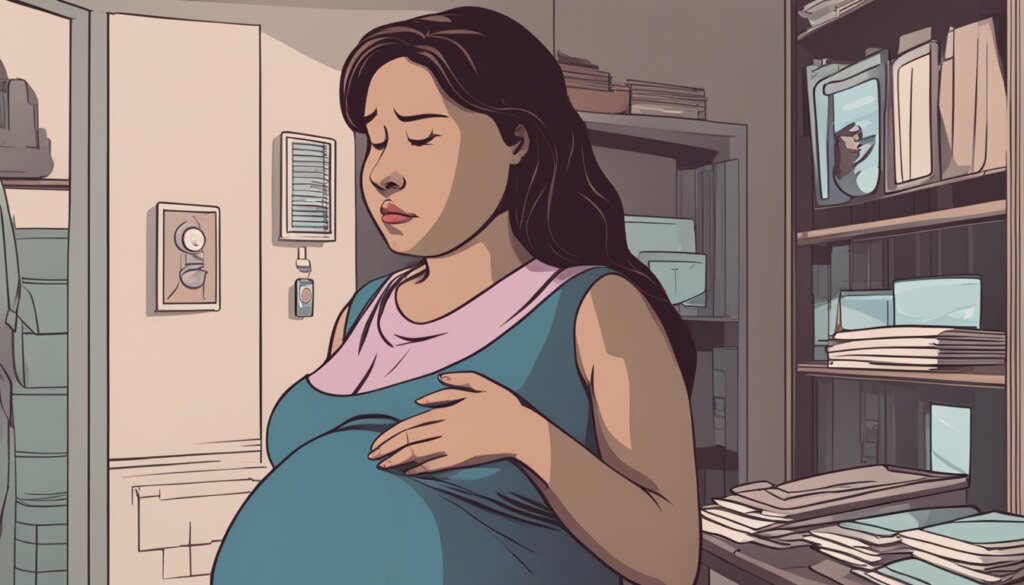
If you have ongoing, bad, or worrying belly pain during pregnancy, get help right away. A doctor can figure out what’s wrong and help you and your baby stay safe.
Post-meal Abdominal Pain
Abdominal pain can often be triggered or exacerbated by the foods we consume. Indigestion, gas, and constipation are common causes of post-meal discomfort.
Food intolerances, such as lactose intolerance, as well as food poisoning, can also lead to abdominal pain and other gastrointestinal symptoms after eating certain foods.
Indigestion, Gas, and Food Intolerances
A survey across 26 countries found 1 in 10 people experience post-meal abdominal pain. 13% of women and 9% of men reported frequent gastrointestinal discomfort after eating. Those with post-meal pain had twice the rates of anxiety and depression.
Food allergies and intolerances can lead to persistent gastrointestinal symptoms affecting many individuals
Irritable Bowel Syndrome (IBS) is a common disorder affecting the large intestine with symptoms like bloating and abdominal cramping. Gastritis, linked to inflammation of the stomach lining, can cause symptoms such as abdominal pain and nausea, among others.
Celiac Disease, an immune disease triggered by gluten, can result in symptoms like abdominal pain, weight loss, and mood changes.
Inflammatory Bowel Disease (IBD) symptoms may include abdominal pain, persistent diarrhea, and blood in stool. Gastroesophageal Reflux Disease (GERD) can cause pain in the upper abdomen or throat, along with heartburn and nausea. Overeating or consuming difficult-to-digest foods can lead to abdominal pain post-meal.
25% of Americans experience dyspepsia or indigestion each year Up to 30% of people with dyspepsia also have Irritable Bowel Syndrome (IBS).
Celiac disease, an autoimmune disorder triggered by gluten, can lead to abdominal pain after consuming gluten. Various viral and bacterial infections can cause gastroenteritis, resulting in abdominal cramps and pain after eating.
Food poisoning symptoms include stomach pain, vomiting, diarrhea, nausea, and high temperature. Overfilling the stomach regularly can lead to discomfort after eating. Gastritis can cause stomach pain, sickness, vomiting, and indigestion.
Condition | Symptoms |
|---|---|
Irritable Bowel Syndrome (IBS) | Stomach cramps, bloating, constipation, and diarrhea |
Heartburn/Gastroesophageal Reflux (GER) | Burning sensation in the chest and throat |
Celiac Disease | Stomach pain, constipation, diarrhea, and bloating |
Constipation | Stomach pain and bloating |
In summary, post-meal abdominal pain can have a variety of underlying causes, from indigestion and gas to food intolerances and infections. Understanding the specific symptoms and seeking medical attention can help identify and address the root cause of this discomfort.
Location-specific Abdominal Pain
The spot where you feel your abdominal pain can tell you a lot about what’s wrong. Knowing what problems are linked to different areas can help you figure out what’s causing your pain. This can lead you to get the right medical help.
Lower Left Abdomen
Pain in the lower left often means you might have diverticulitis. This is when small pouches in your colon get inflamed. It could also be from irritable bowel syndrome (IBS), a long-term issue that causes discomfort, bloating, and changes in how often you go to the bathroom.
Upper Left Abdomen
Pain in the upper left could be related to the pancreas, stomach, or spleen. Issues like stomach ulcers or a bigger-than-usual spleen can also cause pain here.
Lower Right Abdomen
Pain in the lower right is often a sign of appendicitis, a serious issue that needs quick medical care. This pain is usually sudden, very bad, and might make you feel sick, throw up, and not want to eat.
Upper Right Abdomen
Issues in the upper right can come from the liver, gallbladder, or bile ducts. Problems like inflammation of the gallbladder or gallstones can make you feel pain here.
Remember, where your pain is just one clue. It’s also important to think about how bad the pain is, how long it lasts, and any other symptoms you have. This helps your doctor figure out what’s wrong and how to treat it.
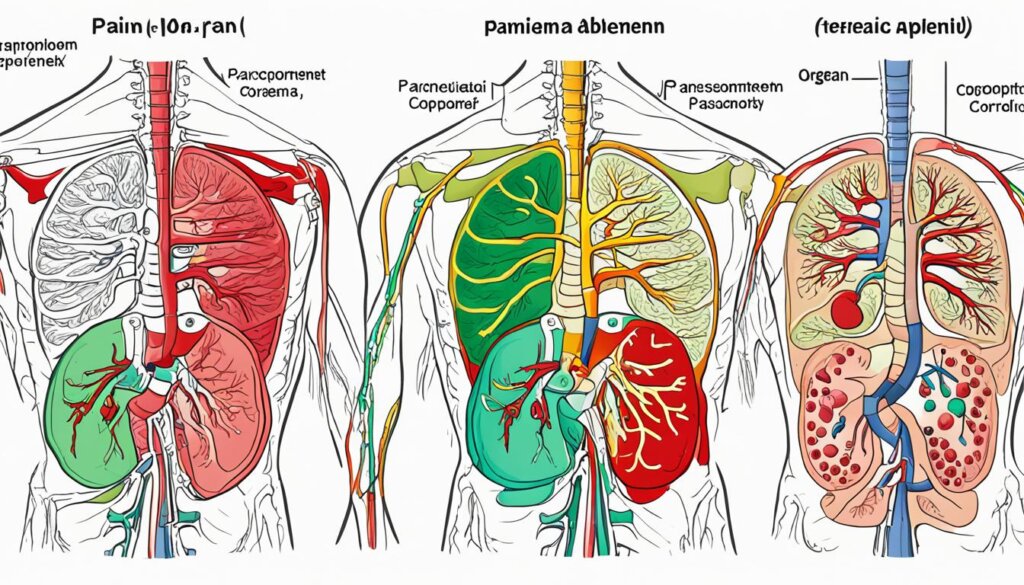
“Abdominal pain can be a complex and challenging symptom, but understanding the various causes and their associated locations can be a valuable diagnostic tool.”
Abdominal Pain Location | Potential Causes |
|---|---|
Lower Left Abdomen | Diverticulitis, Irritable Bowel Syndrome (IBS) |
Upper Left Abdomen | Pancreatitis, Stomach Ulcers, Enlarged Spleen |
Lower Right Abdomen | Appendicitis |
Upper Right Abdomen | Gallbladder Inflammation, Gallstones |
Conclusion
Abdominal pain is common and often not serious. But, it can also mean something serious is wrong. Knowing the types, causes, and signs of abdominal pain helps you get the right medical care. If you have sudden, bad, or ongoing pain, see a doctor to find out why and get help.
Being careful and paying attention to your belly can help you manage your pain and feel better. Doctors use history, exams, and tests to figure out or rule out serious belly pain. Even if the pain is mild, see a doctor if it doesn’t go away or gets worse.
In short, knowing about abdominal pain helps you make smart health choices. It tells you when to get medical help for serious symptoms and what could be causing it, from nothing to something very serious. By being careful and taking action, you can fix any problems and feel better overall.
FAQ
What is abdominal pain?
Abdominal pain is discomfort in your belly. It can be mild or severe, sharp or dull, and constant or not. It’s between your ribs and pelvis.
What are the different types of abdominal pain?
There are many types of abdominal pain. It can start suddenly or last a long time. It can also get worse or come in waves.
How common is abdominal pain?
Almost everyone has had abdominal pain at some point. It’s a big reason for visits to the emergency room.
How can the location of abdominal pain provide clues about the underlying cause?
Doctors look at where the pain is to figure out what’s causing it. Pain in the upper right might mean liver or gallbladder issues. Lower right pain could be appendicitis.
Left-sided pain might be from the stomach or pancreas. Lower left pain often means diverticulitis or irritable bowel syndrome.
What are the characteristics of acute abdominal pain?
Acute abdominal pain comes on suddenly, often in a few hours or days. It can be severe and may mean a serious issue, like appendicitis or gallstones.
What are the characteristics of chronic abdominal pain?
Chronic pain lasts over 3 months and can come and go. It might mean an ongoing condition, like irritable bowel syndrome. Pain that gets worse or comes in waves could be serious.
What are some digestive system causes of abdominal pain?
Many pains come from the digestive system. Issues like indigestion, gas, and constipation can cause discomfort. Food intolerances and food poisoning can also lead to pain.
What are some inflammatory causes of abdominal pain?
Inflammation can cause pain too. Viral gastroenteritis, or stomach flu, can irritate the digestive tract. Conditions like peptic ulcer disease and gastroesophageal reflux disease can also cause pain.
How can abdominal pain originate from the reproductive system?
Women can have pain from their reproductive system. Menstrual cramps and ovulation pain are common. Serious issues like an ectopic pregnancy can also cause severe pain.
What are some serious underlying conditions that can cause abdominal pain?
Some pains are serious. Conditions like appendicitis, gallstones, and pancreatitis can cause severe pain. Cancer in organs like the stomach or pancreas can also cause pain.
How can abdominal pain be related to pregnancy?
Pregnancy can bring abdominal pain. Normal pains include round ligament pain and gas. But, it can also mean serious issues like an ectopic pregnancy or preeclampsia.
How can certain foods trigger or exacerbate abdominal pain?
Foods can make abdominal pain worse. Indigestion and gas are common culprits. Food intolerances and poisoning can also cause pain.
How can the location of abdominal pain provide clues about the underlying cause?
Where the pain is can help figure out the cause. Lower left pain might be diverticulitis. Upper left pain could be from the pancreas.
Lower right pain often means appendicitis. Upper right pain could be from the liver or gallbladder.
